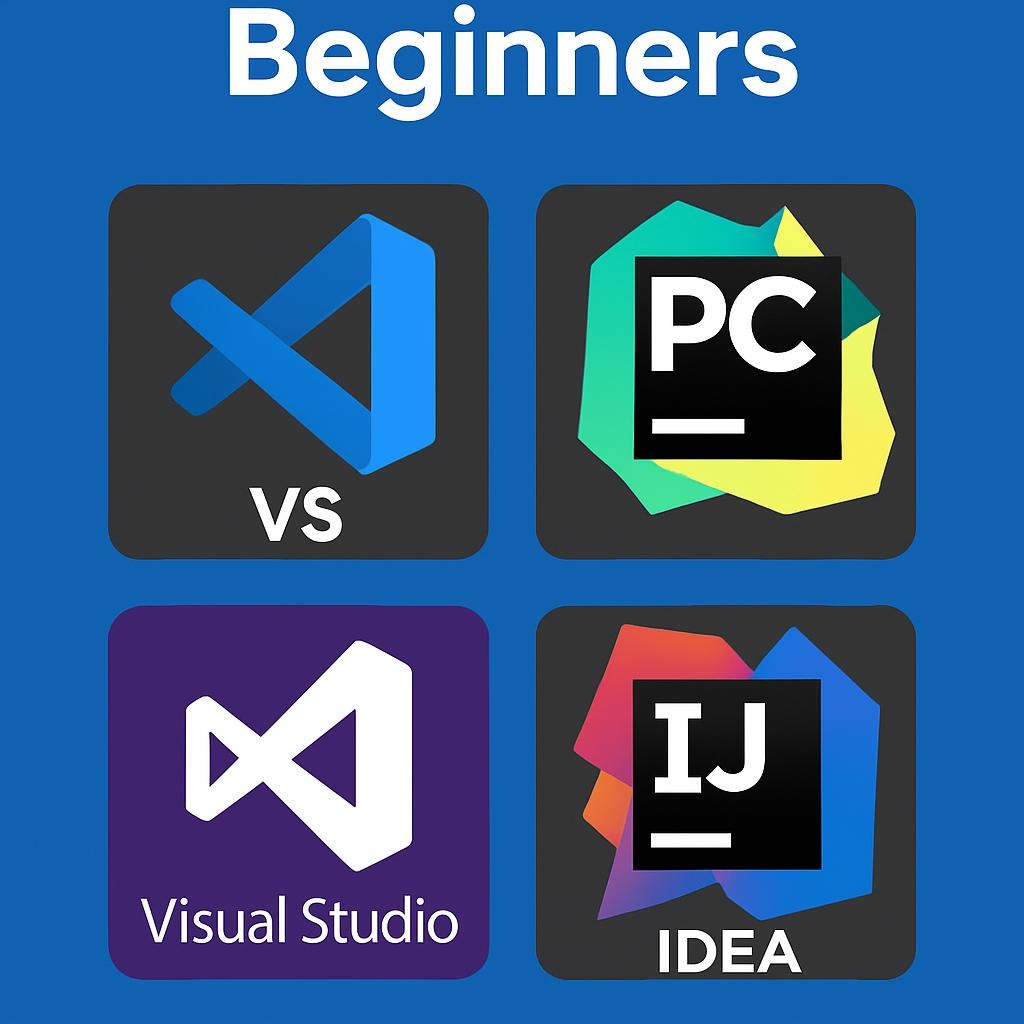Best IDEs for Beginners
The programming landscape has transformed dramatically in 2025, with artificial intelligence reshaping how developers work and new technologies demanding more sophisticated development environments. Yet for beginners stepping into this exciting world, the abundance of choices can feel overwhelming. Python continues to dominate as the most popular language for those learning to code, while developers increasingly want to work with multiple technologies simultaneously.
The good news? You don’t need expensive software to start your programming journey. Today’s free Integrated Development Environments (IDEs) offer enterprise-grade features that would have cost thousands of dollars just a decade ago. With 70% of new business applications expected to use low-code or no-code technologies by 2025, having the right development environment has never been more crucial for beginners looking to build both traditional applications and modern AI-powered solutions.
TL;DR: Key Takeaways
💡 Quick Wins for Beginners:
- Visual Studio Code remains the #1 choice for beginners across all programming languages
- Free doesn’t mean limited – today’s no-cost IDEs rival premium alternatives
- Cloud-based IDEs like GitHub Codespaces eliminate setup complexity for absolute beginners
- Language-specific IDEs (PyCharm Community, Eclipse) offer deeper features for focused learning
- AI-powered features in 2025 IDEs provide real-time coding assistance and error detection
- Cross-platform compatibility ensures your skills transfer regardless of the operating system
- Extension ecosystems let you customize your environment as you grow
What Is an IDE?
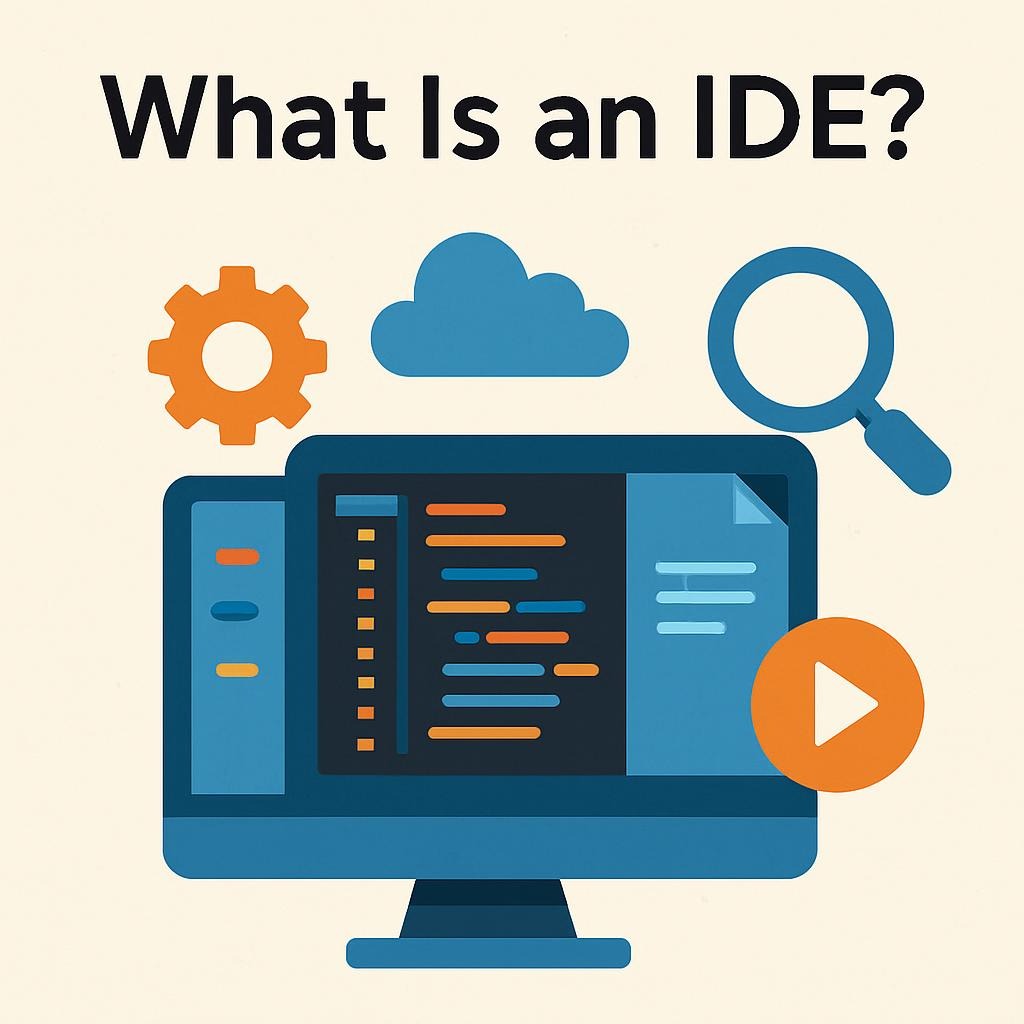
An Integrated Development Environment (IDE) is your digital workbench for programming – a comprehensive software application that combines all the essential tools you need to write, test, and debug code in one unified interface. Think of it as the difference between building a house with individual hand tools scattered across a worksite versus having a fully equipped workshop with everything organized and easily accessible.
IDE vs. Code Editor vs. Text Editor
| Feature | Text Editor | Code Editor | Full IDE |
|---|---|---|---|
| Purpose | Basic text editing | Code-focused editing | Complete development suite |
| Syntax Highlighting | None | ✓ | ✓ |
| Auto-completion | None | Basic | Advanced with AI |
| Built-in Debugger | None | Plugin-based | ✓ |
| Project Management | None | File explorer | Full project structure |
| Version Control | None | Basic Git | Integrated Git/SVN/etc. |
| Terminal Integration | None | External | Built-in |
| Plugin Ecosystem | None | Moderate | Extensive |
| Learning Curve | Minimal | Moderate | Steeper but more rewarding |
💡 Pro Tip: Start with a code editor like VS Code if you’re completely new to programming, then graduate to full IDEs like IntelliJ IDEA or PyCharm as your projects become more complex.
Why Choose Free IDEs in 2025?
The Cost-Benefit Reality
The development tools market has undergone a seismic shift. Major companies like Microsoft have made their flagship development tools free to attract the next generation of developers, while the rise of open-source software has created robust alternatives to expensive proprietary solutions.
Key Advantages of Modern Free IDEs:
🚀 Enterprise-Grade Features at Zero Cost
- Advanced debugging capabilities
- Intelligent code completion
- Built-in version control
- Extensive plugin ecosystems
🔄 Regular Updates and Community Support
- Monthly feature releases
- Active developer communities
- Rapid bug fixes and security updates
- Continuous integration with the latest programming trends
🌐 Cloud Integration
- Seamless integration with GitHub, GitLab
- Cloud-based development environments
- Collaboration features for team projects
🤖 AI-Powered Assistance Modern free IDEs now include AI features that were premium-only just two years ago:
- Intelligent code suggestions
- Automatic error detection and fixes
- Code explanation and documentation generation
- Language translation between programming languages
The Top Free IDEs for Beginners (2025 Rankings)
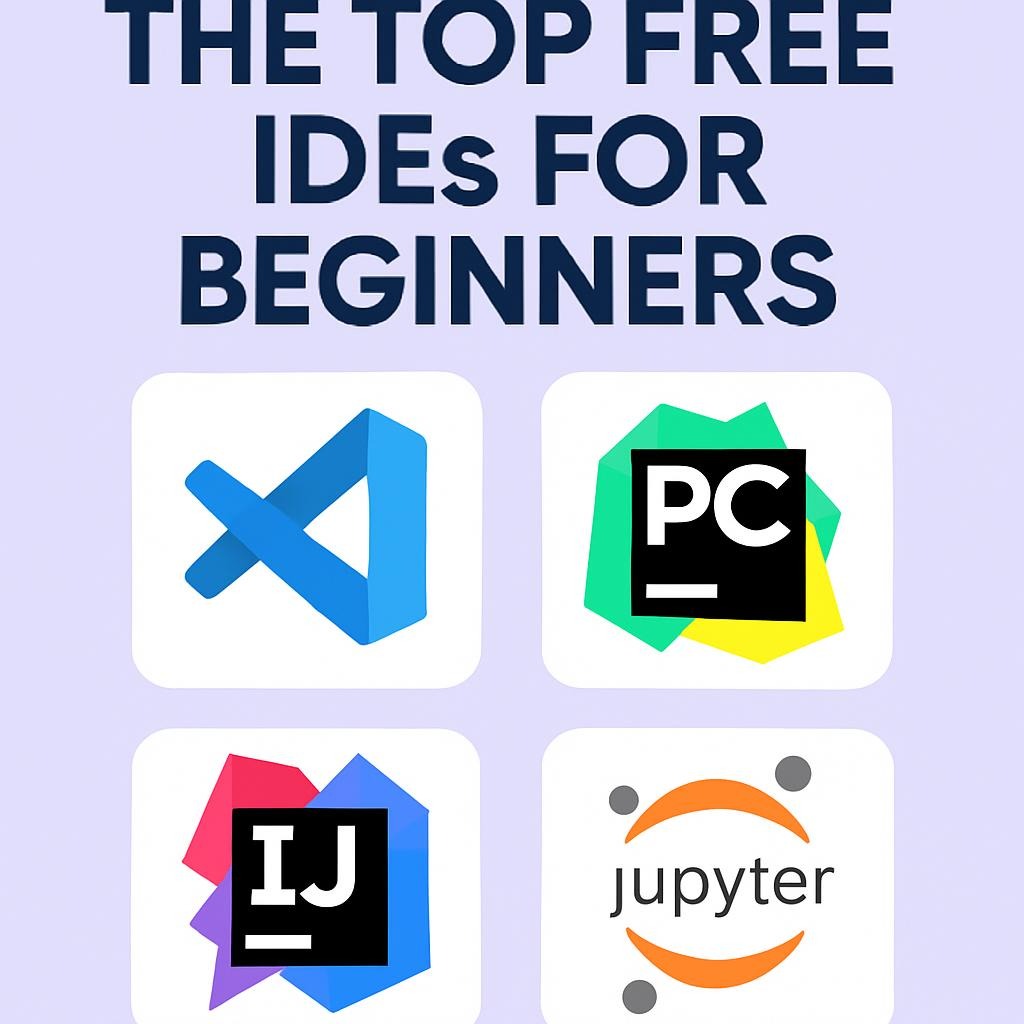
1. Visual Studio Code – The Universal Champion
Best For: Beginners across all programming languages
Learning Curve: Easy (1-2 weeks to proficiency)
File Size: ~200MB
Platforms: Windows, macOS, Linux
VS Code supports most programming languages, is completely free, and boasts a massive library of extensions, making it the go-to recommendation for beginners worldwide.
🌟 Standout Features:
- IntelliSense: AI-powered code completion that learns your patterns
- Live Share: Real-time collaboration with other developers
- Integrated Git: Version control without leaving the editor
- Extensions Marketplace: 50,000+ extensions covering every conceivable need
- Multi-language Support: From Python and JavaScript to Rust and Go
Beginner-Friendly Highlights:
- Welcome Tab: Interactive tutorials and quick start guides
- Command Palette: Type what you want to do instead of hunting through menus
- Problems Panel: Clear explanations of errors with suggested fixes
- Settings Sync: Your preferences follow you across devices
💡 Pro Tip: Install the “Extension Pack for New Users,” which includes essential extensions like Prettier (code formatting), GitLens (enhanced Git), and Bracket Pair Colorizer.
2. PyCharm Community Edition – Python Powerhouse
Best For: Python beginners and data science students
Learning Curve: Moderate (2-3 weeks for full utilization)
File Size: ~400MB
Platforms: Windows, macOS, Linux
While VS Code is a generalist, PyCharm Community Edition is the specialist that makes Python development feel effortless.
🐍 Python-Specific Excellence:
- Smart Code Navigation: Jump to definitions, find usages across your entire project
- Advanced Debugging: Step through code line-by-line with variable inspection
- Scientific Tools: Built-in support for Jupyter notebooks, matplotlib, and pandas
- Django Support: Web framework integration with template debugging
Learning Advantages:
- Code Inspections: Real-time analysis identifying potential issues
- Refactoring Tools: Safely rename variables, extract methods, reorganize code
- Virtual Environment Management: Automatic handling of Python environments
- Database Tools: Query and manage databases directly from the IDE
3. Eclipse IDE – The Java Foundation
Best For: Java beginners and enterprise development learners
Learning Curve: Moderate to steep (3-4 weeks)
File Size: ~300MB (base installation)
Platforms: Windows, macOS, Linux
Eclipse has been the backbone of Java education for over two decades, and its 2025 iteration brings modern features while maintaining its educational focus.
☕ Java Excellence:
- Comprehensive Java Support: From Java 8 to the latest Java 21 features
- Maven/Gradle Integration: Modern build tool support
- JUnit Integration: Built-in testing framework support
- Memory Analysis: Tools to understand and optimize Java performance
Educational Features:
- Extensive Documentation: Built-in help system with examples
- Code Templates: Speed up common programming patterns
- Plugin Architecture: Extend functionality as your skills grow
- Workspace Concepts: Organize multiple projects efficiently
4. IntelliJ IDEA Community Edition – Professional Grade
Best For: Multi-language beginners planning professional development Learning Curve: Moderate (2-3 weeks) File Size: ~600MB Platforms: Windows, macOS, Linux
JetBrains IDEs like IntelliJ IDEA continue to be faster, smarter, and more feature-packed, making the Community Edition an exceptional choice for ambitious beginners.
🎯 Professional Features:
- Intelligent Code Completion: Context-aware suggestions that understand your intent
- Built-in Developer Tools: Version control, terminal, database tools
- Framework Support: Spring Boot, Android, and more
- Code Quality Analysis: Detect code smells and suggest improvements
Career-Ready Skills:
- Debugging Mastery: Professional-grade debugging tools
- Refactoring Excellence: Industry-standard code restructuring capabilities
- Testing Integration: JUnit, TestNG, and other testing frameworks
- Build Tool Support: Maven, Gradle, and Ant integration
5. Thonny – The Beginner’s Best Friend
Best For: Absolute programming beginners and Python education
Learning Curve: Very easy (1 week)
File Size: ~15MB
Platforms: Windows, macOS, Linux
Thonny IDE has a basic interface with key features like highlighting errors, code completion, step-by-step expression evaluation, and debugging, serving as a great environment for full-fledged Python projects despite being recommended for beginners.
🎓 Educational Focus:
- Beginner Mode: Simplified interface that doesn’t overwhelm
- Step-by-Step Execution: Watch your code execute line by line
- Variable Inspector: See how data changes as your program runs
- Simple Package Manager: Install Python libraries with one click
6. GitHub Codespaces – Cloud Development Revolution
Best For: Beginners who want zero setup complexity
Learning Curve: Easy (immediate start)
Cost: Free tier: 60 hours/month
Platforms: Any device with a web browser
Cloud-based development environments like those offered by various platforms let you code in multiple languages directly from your browser with minimal configuration.
☁️ Cloud Advantages:
- Instant Setup: Start coding immediately without installations
- Consistent Environment: Same setup across all your devices
- Powerful Hardware: Access to better computing resources than your local machine
- Pre-configured Templates: Start projects with batteries included
Detailed Feature Comparison Matrix
| IDE | Languages | AI Features | Debugging | Cloud Sync | Mobile Support | Best For |
|---|---|---|---|---|---|---|
| VS Code | All major languages | GitHub Copilot integration | Excellent | ✓ | Limited | General programming |
| PyCharm CE | Python, HTML/CSS/JS | Code completion AI | Advanced | ✓ | None | Python specialists |
| Eclipse | Java, C/C++, PHP | Basic | Professional | ✓ | None | Java enterprise |
| IntelliJ CE | Java, Kotlin, Groovy | Smart completion | Professional | ✓ | None | Professional Java developers |
| Thonny | Python only | None | Educational | None | None | Learning Python |
| Codespaces | All languages | GitHub Copilot | Cloud-based | Native | ✓ | Zero-setup coding |
Setting Up Your First IDE: Step-by-Step Guide
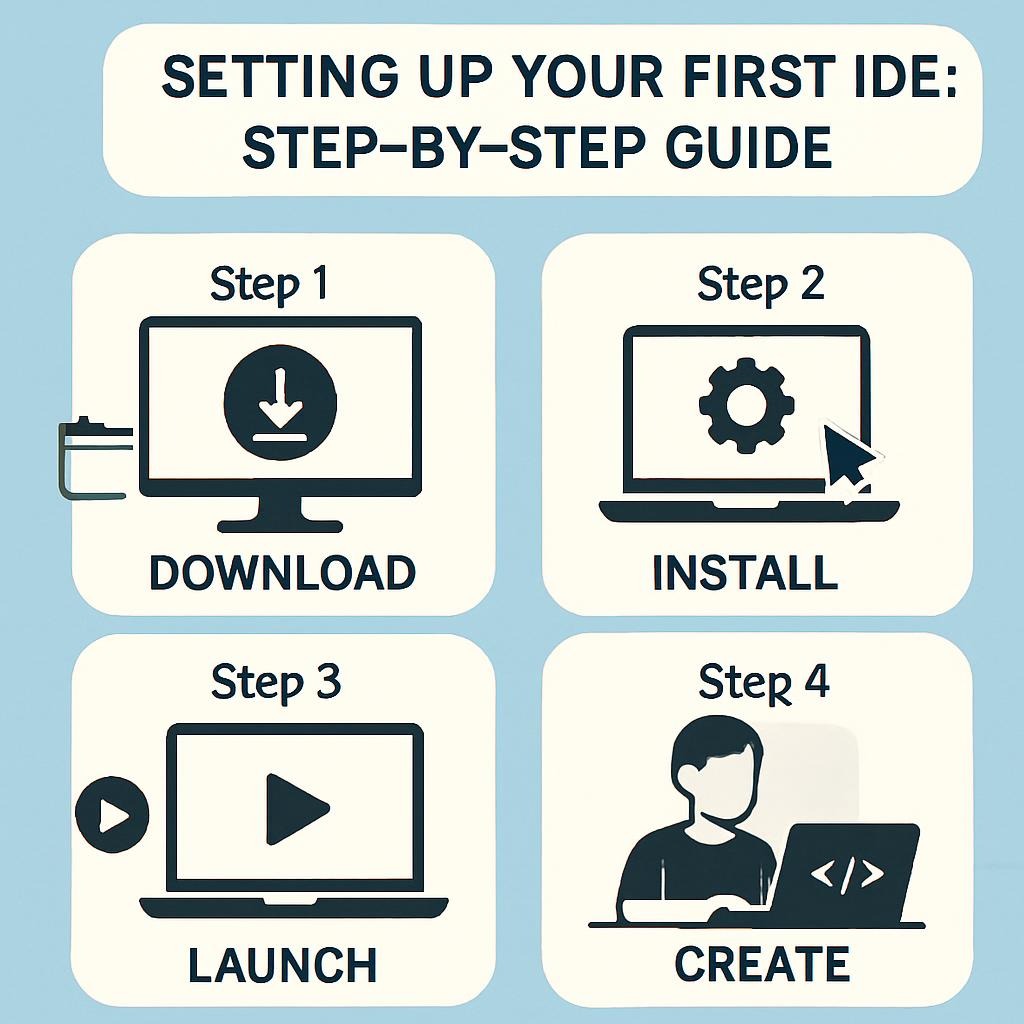
Method 1: Visual Studio Code (Recommended for Most Beginners)
Step 1: Download and Install
- Visit code.visualstudio.com
- Download for your operating system
- Run the installer with default settings
Step 2: Essential Extensions Setup
- Open Extensions panel (Ctrl+Shift+X)
- Install these must-haves:
- Python (by Microsoft) – if learning Python
- Prettier – Code formatter
- GitLens – Enhanced Git integration
- Live Server – For web development
- Error Lens – Inline error display
Step 3: Configure for Success
json
// Add to settings.json (Ctrl+,)
{
"editor.formatOnSave": true,
"editor.minimap.enabled": true,
"workbench.colorTheme": "Dark+ (default dark)",
"editor.fontSize": 14,
"editor.tabSize": 4
}Step 4: Create Your First Project
- File → Open Folder
- Create a new folder for your project
- File → New File → save as
hello.py(or your language extension) - Start coding!
Method 2: Cloud Setup with GitHub Codespaces
Instant Gratification Setup:
- Sign up for a GitHub account (free)
- Go to github.com/codespaces
- Click “New codespace”
- Choose a template (Python, Node.js, etc.)
- Start coding in your browser immediately
💡 Pro Tip: Use Codespaces for your first few weeks while you decide which local IDE you prefer. This eliminates setup frustration that derails many beginners.
Language-Specific Recommendations
Python Learners
- First Choice: Thonny (absolute beginners)
- Growth Path: VS Code with Python extension
- Advanced: PyCharm Community Edition
Web Development (HTML/CSS/JavaScript)
- First Choice: VS Code with Live Server
- Alternative: Brackets (for design-focused approach)
- Advanced: WebStorm (if budget allows later)
Java Students
- Educational: Eclipse with EGit plugin
- Professional Path: IntelliJ IDEA Community
- Enterprise Prep: NetBeans (Oracle official IDE)
Multi-Language Explorers
- Universal: VS Code
- Professional: IntelliJ IDEA Ultimate (consider after mastering basics)
- Cloud-First: GitHub Codespaces
Advanced Features Every Beginner Should Learn
Version Control Integration
Why It Matters: Every professional project uses version control. Learning Git through your IDE creates good habits early.
Must-Learn Git Features:
- Staging and Committing: Save snapshots of your progress
- Branching: Experiment safely without breaking working code
- Remote Repositories: Backup and share your code
- Conflict Resolution: Handle competing changes gracefully
IDE Git Tools to Master:
bash
# Essential Git commands available in all major IDEs:
- git init (initialize repository)
- git add . (stage all changes)
- git commit -m "message" (save snapshot)
- git push (backup to remote)
- git pull (sync latest changes)Debugging Like a Professional
Setting Breakpoints:
- Click in the gutter next to line numbers
- Run in debug mode instead of normal run
- Examine variables at each step
- Step through the code line by line
Debug Console Usage:
- Evaluate expressions while paused
- Modify variables during execution
- Test hypotheses about bugs
Extensions and Plugins Ecosystem
Essential Categories:
- Code Formatters: Prettier, Black (Python), Google Java Format
- Linters: ESLint (JavaScript), Pylint (Python), Checkstyle (Java)
- Themes: One Dark Pro, Dracula, Ayu
- Productivity: Bracket Pair Colorizer, Auto Rename Tag, Path Intellisense
💡 Pro Tip: Don’t install too many extensions initially. Add them as you identify specific needs to avoid overwhelming yourself.
Common Beginner Pitfalls and Solutions
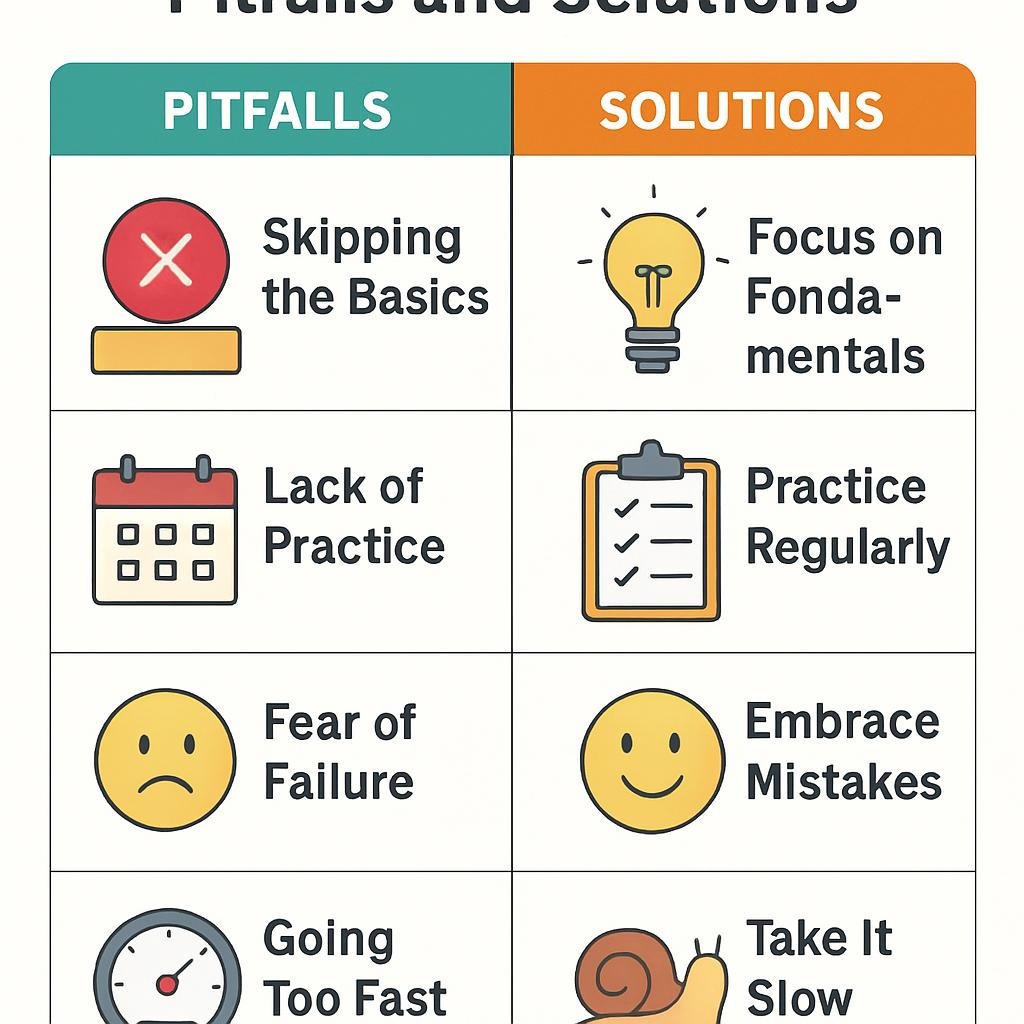
Problem 1: “Too Many Choices Paralysis”
Symptoms: Spending weeks researching instead of coding
Solution: Pick VS Code, spend a maximum of 1 day on setup, start coding
Problem 2: “Over-Customization Addiction”
Symptoms: Constantly tweaking settings and themes
Solution: Set a rule – only customize after completing a full project
Problem 3: “Feature Overwhelm”
Symptoms: Trying to learn every IDE feature simultaneously
Solution: Focus on these core features first:
- Creating/opening files
- Running code
- Basic debugging
- Installing extensions
Problem 4: “Plugin Hoarding”
Symptoms: Installing dozens of extensions “just in case” Solution: Follow the “one project, one plugin” rule – only add extensions when you have a specific need
Problem 5: “Perfect Environment Seeking”
Symptoms: Constantly switching IDEs, looking for the “perfect” one
Solution: Commit to one IDE for your first complete project, then evaluate
Performance and System Requirements
Minimum System Requirements (2025)
| IDE | RAM (Minimum) | Storage | CPU | Works Well On |
|---|
| VS Code | 4GB | 200MB | Dual-core | Most laptops from 2018+ |
| PyCharm CE | 8GB | 2GB | Quad-core | Gaming laptops, workstations |
| Eclipse | 4GB | 300MB | Dual-core | Budget laptops |
| IntelliJ CE | 8GB | 2.5GB | Quad-core | Modern laptops |
| Thonny | 2GB | 15MB | Any | Chromebooks, old laptops |
| Codespaces | 4GB | 0MB local | Any | Tablets, phones, any device (cloud IDE) |
Performance Optimization Tips
For Lower-End Hardware:
- Use Thonny or VS Code instead of JetBrains IDEs
- Disable fancy animations and effects
- Close unnecessary extensions
- Use cloud IDEs for resource-intensive tasks
For Older Computers:
- Consider Sublime Text (a lightweight alternative)
- Use browser-based IDEs like Replit or CodePen
- Cloud development with Codespaces
- Linux distros with lightweight IDEs
Security and Best Practices
IDE Security in 2025
Extension Safety:
- Only install extensions from official marketplaces
- Check extension permissions before installing
- Regularly review and remove unused extensions
- Keep extensions updated
Code Security:
- Never commit passwords or API keys
- Use environment variables for sensitive data
- Enable two-factor authentication on GitHub/GitLab
- Regularly update your IDE
Privacy Considerations
Data Collection Awareness:
- Most IDEs collect usage analytics
- Review privacy settings during installation
- Understand what data syncs to cloud accounts
- Consider offline-focused alternatives if privacy is crucial
💡 Pro Tip: Create separate GitHub accounts for learning vs. professional work to maintain privacy boundaries.
The Road Ahead: Learning Path Recommendations

Month 1-2: Foundation Building
- Week 1-2: Master basic IDE navigation and file management
- Week 3-4: Learn debugging basics and version control
- Week 5-8: Focus on coding, not IDE features
Month 3-4: Intermediate Skills
- Advanced debugging: Conditional breakpoints, watch expressions
- Plugin mastery: Install and configure productivity extensions
- Project organization: Learn workspace and project management
- Keyboard shortcuts: Memorize 10-15 essential shortcuts
Month 5-6: Professional Preparation
- Code review tools: Learn diff views and merge conflict resolution
- Testing integration: Run unit tests from IDE
- Database tools: Connect and query databases from IDE
- Collaboration: Use Live Share or similar collaborative features
Beyond 6 Months: Specialization
- Consider paid IDEs: If specific language focus emerges
- Advanced tooling: Profilers, memory analyzers, performance tools
- Team integration: CI/CD integration, deployment tools
- Custom extensions: Create your own productivity tools
People Also Ask (PAA) Section
Q: Is VS Code really free forever, or will Microsoft start charging? A: VS Code is open-source (MIT license) and will remain free. Microsoft’s business model focuses on Azure cloud services and enterprise tools, not individual IDE licensing.
Q: Can I use these free IDEs for commercial projects? A: Yes, all recommended IDEs have licenses permitting commercial use. Check specific license terms, but major IDEs like VS Code, Eclipse, and PyCharm Community explicitly allow commercial development.
Q: Which IDE should I choose if I want to learn multiple programming languages? A: VS Code is the clear winner for multi-language learning, supporting virtually every programming language with excellent extension support and a consistent interface across languages.
Q: Do I need different IDEs for web development vs. mobile app development? A: Not necessarily. VS Code handles web development excellently, and with extensions, can support React Native, Flutter, and other mobile frameworks. Specialized IDEs like Android Studio become valuable for native Android development.
Q: How much storage space should I allocate for IDE and projects? A: Plan for 5-10GB minimum: IDE (500MB-2GB), programming language tools (1-3GB), and project space (2-5GB). Cloud storage integration reduces local requirements.
Q: Can I code on a tablet or Chromebook with these IDEs? A: Yes, through cloud IDEs like GitHub Codespaces, Replit, or CodeSandbox. Some IDEs like VS Code also offer web versions, though with limited functionality compared to desktop versions.
Frequently Asked Questions

Q: Should beginners use cloud-based or desktop IDEs? A: Cloud IDEs like Codespaces are perfect for absolute beginners due to zero setup complexity, but desktop IDEs offer better performance and offline capability. Consider starting with the cloud, then transitioning to the desktop as skills develop.
Q: How important are AI coding assistants for beginners? A: AI assistants like GitHub Copilot can accelerate learning by suggesting code patterns and explaining errors. However, balance AI assistance with understanding underlying concepts to avoid developing dependency without comprehension.
Q: Can I switch IDEs later without losing my progress? A: Yes, your actual code files are IDE-independent. Most settings, extensions, and preferences need reconfiguration when switching, but your programming skills and project files transfer seamlessly.
Q: What’s the biggest mistake beginners make when choosing an IDE? A: Analysis paralysis – spending more time researching tools than actually coding. Pick a well-regarded option like VS Code and focus on learning programming concepts rather than perfecting your development environment.
Q: Are there any hidden costs with “free” IDEs? A: The IDEs listed are genuinely free with no hidden costs. Optional paid additions include premium themes, cloud storage beyond free tiers, and AI assistants, but core functionality remains free indefinitely.
Q: How do I know when I’ve outgrown my beginner IDE? A: Signs include: needing language-specific features your current IDE lacks, working on large projects where performance matters, or joining teams using specific development workflows. This typically happens after 6-12 months of consistent programming.
Conclusion: Your Coding Journey Starts Now
The world of programming has never been more accessible to beginners. With Python continuing to dominate as the most popular language for new programmers and developers increasingly working with multiple technologies, having the right IDE can make the difference between a frustrating learning experience and an exciting journey of discovery.
The IDEs recommended in this guide – from the universal appeal of VS Code to the educational focus of Thonny – represent the best balance of power, usability, and cost (free!) available in 2025. Each offers a path from beginner confusion to professional competence, with communities and resources to support your growth.
Remember the golden rule: The best IDE is the one you’ll actually use consistently. Don’t get caught in the trap of endless tool optimization. Pick VS Code if you’re unsure, spend one day setting it up, then focus on writing code and building projects.
Your programming journey is about to begin. The tools are ready, the resources are available, and the only thing standing between you and your first “Hello, World!” is clicking that download button.
Ready to start coding? Download VS Code now and write your first program today. Share your progress and questions in programming communities – the 2025 developer ecosystem is incredibly welcoming to beginners eager to learn.
References and Further Reading
- Stack Overflow. (2025). 2024 Developer Survey Results. Retrieved from https://stackoverflow.blog/2025/01/01/developers-want-more-more-more-the-2024-results-from-stack-overflow-s-annual-developer-survey/
- GeeksforGeeks. (2025). Top 10 Free Online IDEs, Compilers in 2025. Retrieved from https://www.geeksforgeeks.org/blogs/free-online-ide-compilers/
- Pieces. (2025). 11 Best IDEs for Python developers in 2025. Retrieved from https://pieces.app/blog/best-ide-for-python
- The CTO Club. (2025). 19 Best IDE Software Picks of 2025. Retrieved from https://thectoclub.com/tools/best-ide-software/
- SlashDev. (2024). Best Free Code Editors and IDEs for Developers in 2025. Retrieved from https://slashdev.io/-best-free-code-editors-and-ides-for-developers-in-2025
- Design Rush. (2025). 35 Software Development Statistics: Key Insights and Trends for 2025. Retrieved from https://www.designrush.com/agency/software-development/trends/software-development-statistics
- WeblineIndia. (2025). 100+ Software Development Statistics & Trends: 2025 and Beyond. Retrieved from https://www.weblineindia.com/blog/software-development-statistics-trends/
- Index.dev. (2025). 20 Most Popular Programming Languages in 2025. Retrieved from https://www.index.dev/blog/most-popular-programming-languages-
- Graphite. (2025). Software development trends in 2025: What developers need to know. Retrieved from https://graphite.dev/guides/software-development-trends-2025
- App Builder. (2025). Low-Code Statistics And Trends 2025. Retrieved from https://www.appbuilder.dev/low-code-statistics
